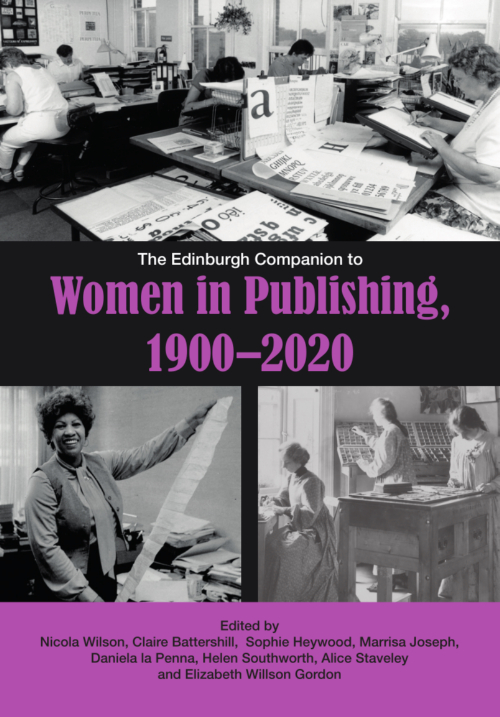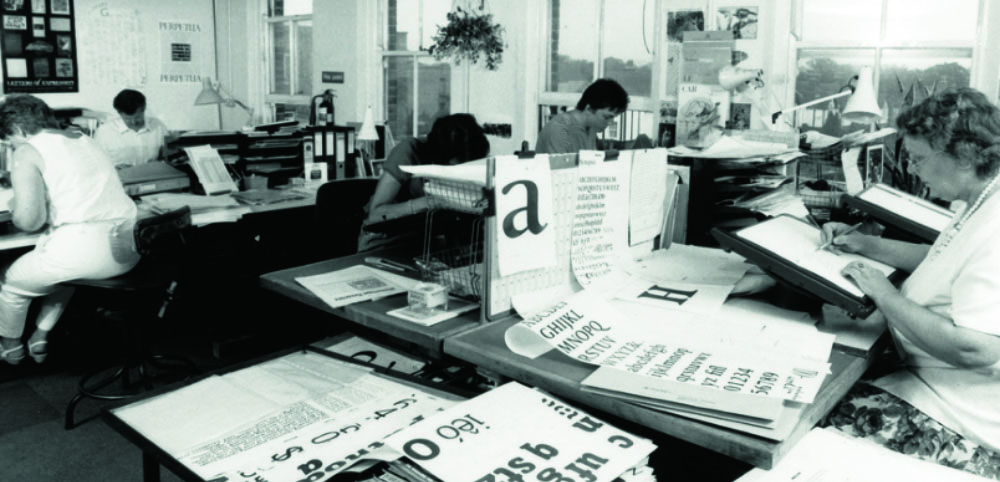
by Nicola Wilson, Claire Battershill, Sophie Heywood, Marrisa Joseph, Daniela La Penna, Helen Southworth, Alice Staveley and Elizabeth Willson Gordon
The Edinburgh Companion to Women in Publishing, 1900-2020 highlights the long history of women’s work as editors and publishers, designers, booksellers, type drawers, illustrators, agents, and more. With thirty-three deeply-researched chapters and interviews with contemporary women in publishing, it goes beyond the Anglosphere and aims to define a new field of intersectional feminist approaches to book and publishing history.
As we argue in the Introduction (available open access here), we need a feminist publishing history to uncover the previously undervalued creative and intellectual labour performed by women in the creative industries.
Q&A with the editors – Here are some of the editors’ highlights:
Claire Battershill: ‘I’m excited by all of the amazing images in this volume (and want to thank EUP for allowing us so many!) that, taken together, allow us to construct a new visual culture of publishing in the 20th century. Particularly exciting are the images of the women working in the type drawing offices for Monotype in Fiona Ross and Alice Savoie’s essay: that archive is now closed and this volume shows a number of images that will otherwise be inaccessible to researchers.’
Sophie Heywood: ‘It has been fascinating to be involved in a project of such vast scope and ambition. Just two highlights of working on the book (I can think of so many, but will restrain myself!): First has been the opportunity to dive into the innovative scholarship through a gendered lens that is shifting paradigms and practices within the history of the book and publishing. Second, the generosity of all the interviewees who spoke to Marrisa about their experiences of the publishing industry. Their words threw into relief the historical perspectives set out in the book chapters, and allowed us to see just how far things have changed for women in publishing in a relatively short space of time.’
Marrisa Joseph: ‘Connecting with the interviewees was such a rewarding experience. Listening to them recount what gave them their initial sparks to fall in love with the publishing industry, and tracing key moments that influenced their careers was fascinating. Their passion shines through their words and I hope that their stories provide inspiration for future generations of women in publishing.’
Daniela La Penna: ‘I am very proud of the geographical reach this volume achieves. We have chapters covering the cultural action of women who worked across nations, continents and languages, often acting as a bridge to foster long-lasting collaborations and change in their respective fields of professional interest. The volume is packed with insightful essays on the labour, sweat, tears (and the occasional laughter at the expense of patriarchy) of trailblazing, trend-setting women but also those who worked and stayed in the shadows, until now that is! Inevitably, when one tries to map half of the publishing world, there are some gaps. My hope (and one that is shared by my colleagues working on this volume) is that the research showcased in this volume will inspire established and emerging scholars to engage with this important work.’
Helen Southworth: ‘The chapters and interviews in this volume represent just the tip of the iceberg in terms of women’s contributions to the publishing business and we’re hopeful our work will inspire other researchers to bring out into the open stories of women’s contributions to the production and promotion of books. Every chapter finds the reader in the company of an extraordinary woman or group of women working against the odds, from Una Marson’s self-publishing in her native Jamaica to M.Eleanor Fitzgerald’s Fitzi’s “vital” behind-the-scenes managing of U.S. modernist art and activism to Esther Tusquets’ and Rosa Regas’ mobilizing their publishing enterprises to resist the repression of the Franco regime in Spain.’
Alice Staveley: ‘For me, this book represents in both its editorial design and its historical contents the power of collective feminist action to change longstanding critical or institutional narratives about women, work, and publishing, both within and without the academy. What began with the efforts of a subset of our editorial team on The Modernist Archives Publishing Project (MAPP), led to a desire to expand the range, diversity, and archival resources for where the ‘lost’ stories of women’s manifold roles in the publishing industry might be found and brought back to public view. Our unconventionally large editorial collective was in service of that goal. We were lucky to work with Edinburgh University Press who wholeheartedly allowed us to ‘go big by going together’.
What I loved about working with such a dynamic group of women editors, too, was how our many conversations resonated with the traces of women’s talk sprinkled liberally throughout this book, unearthed by our superb contributors: from Toni Morrison’s letters to Toni Cade Bambara; to Grace Hogarth’s letters from America to her associates in the UK; from Barbara Smith and Audre Lorde’s words about founding The Kitchen Table Press; to Natalia Ginsburg’s editorial letters from Italy to the Carcanet Press in London. We invite our readers to share in this rich colloquy, and hope it encourages others to expand upon our work, taking it in unforeseen directions.’
Nicola Wilson: ‘I agree with Kaja Marczewska that the understandable tendency to focus on production as part of feminist publishing practice has obscured the vital role of distribution and circulation – of getting the word out. This is what Marczewska looks at in her study of US second-wave collective WIND (Women in Distribution). Because of this, I really appreciated the contributions we were able to put together to form ‘Part IV: Making – Selling – Distributing’, with chapters on women booksellers, patrons, and designers.’
Elizabeth Willson Gordon: ‘Working on this collection reminded me, once again, of the great range and diversity of contributions made by women across the many aspects of book production. Many chapters also introduce readers to surprising elements of publication history, or offer a new lens for more well-known aspects of book making. The richness of the research is invigorating, and I echo my fellow editors in looking forward to the new and continued research that follows this tapestry of voices.’
About the book

Explores the diversity of women’s work in transatlantic and continental publishing across the twentieth-century
The Edinburgh Companion to Women in Publishing, 1900-2020 is the first collection of its kind, helping to establish and shape a thriving new research field. Find out more and order your copy in hardback or ebook here.
Don’t forget to sign up to our mailing list to keep up to date with all of our free content and latest releases!





